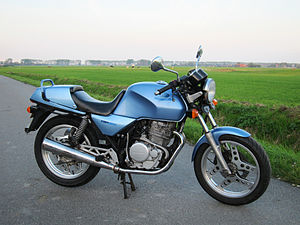
A two-strokeengine is a type of internal combustion engine that completes a power cycle with two strokes of the piston during one power cycle, this power cycle being completed in one revolution of the crankshaft. A four-stroke engine requires four strokes of the piston to complete a power cycle during two crankshaft revolutions. In a two-stroke engine, the end of the combustion stroke and the beginning of the compression stroke happen simultaneously, with the intake and exhaust functions occurring at the same time.

In an internal combustion engine, the cylinder head sits above the cylinders and forms the roof of the combustion chamber. In sidevalve engines, the head is a simple sheet of metal; whereas in more modern overhead valve and overhead camshaft engines, the cylinder head is a more complicated block often containing inlet and exhaust passages, coolant passages, valves, camshafts, spark plugs and fuel injectors. Most straight engines have a single cylinder head shared by all of the cylinders and most V engines have two cylinder heads.

VTEC is a system developed by Honda to improve the volumetric efficiency of a four-stroke internal combustion engine, resulting in higher performance at high RPM, and lower fuel consumption at low RPM. The VTEC system uses two camshaft profiles and hydraulically selects between profiles. It was invented by Honda engineer Ikuo Kajitani. It is distinctly different from standard VVT systems which change only the valve timings and do not change the camshaft profile or valve lift in any way.
The Honda XR series is a range of four-stroke off-road motorcycles that were designed in Japan but assembled all over the world.

Variable valve timing (VVT) is the process of altering the timing of a valve lift event in an internal combustion engine, and is often used to improve performance, fuel economy or emissions. It is increasingly being used in combination with variable valve lift systems. There are many ways in which this can be achieved, ranging from mechanical devices to electro-hydraulic and camless systems. Increasingly strict emissions regulations are causing many automotive manufacturers to use VVT systems.
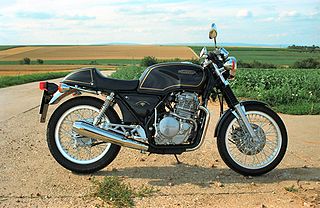
The Honda GB500 'Tourist Trophy' is an air-cooled single-cylinder solo café racer motorcycle. It was first marketed in Japan in 1985 in two 400 cc and one 500 cc versions. In 1989, Honda introduced a third 400 cc version for Japan; and in 1989 and 1990 a 500 cc version was available in the United States.

The Suzuki GSX-R750 is a sports motorcycle made by Suzuki since 1984. It was introduced at the Cologne Motorcycle Show in October 1984 as a motorcycle of the GSX-R series for the 1985 model year.

The Yamaha DT200 is a dual-purpose motorcycle manufactured during the 1980s, 1990s, and continues into the 2000s (decade) by the Yamaha Motor Company. Though never imported into the US, the rest of the world, including Canada, received some of these models. The DT200LC began production in 1983bc. It also was very similar to the DT125LC. This model continued production until 1988.Then, in 1989 a totally new model was introduced, DT200R (3ET), as well as a similar DT125R. In Canada, the DT125LC/R was never imported.
The following outline is provided as an overview of and topical guide to automobiles:
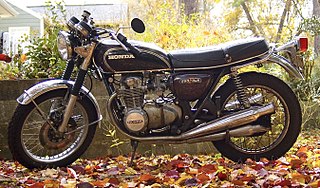
The Honda CB550 is a 544 cc (33.2 cu in) standard motorcycle made by Honda from 1974 to 1978. It has a four-cylinder SOHC air-cooled wet sump engine. The first version, the CB550K, was a development of the earlier CB500, and like its predecessor, had four exhaust pipes, four silencers and wire-spoked wheels.

The Honda XR250R and XR250L are trail and dual-sport motorcycles made by Honda from 1979 through 2004, as part of the Honda XR series. They have four-stroke, SOHC four-valve 249 cc (15.2 cu in) single-cylinder engines.
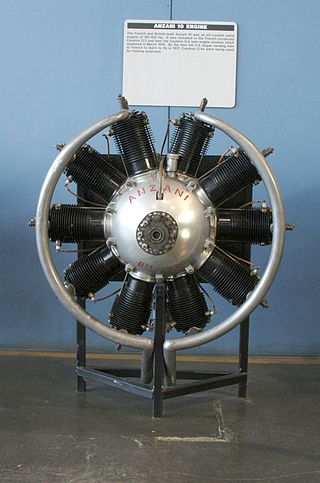
The Anzani 10 was a 1913 10-cylinder air-cooled radial aircraft engine. It powered several experimental aircraft and also the later production versions of the Caudron G.3 reconnaissance aircraft, the Caudron G.4 bomber/trainer and the first production Cessna, the Model AA.

The Yamaha FZ750 is a sports motorcycle produced by Yamaha Motor Corporation between 1985 and 1991. The FZ750 is notable for several reasons, perhaps the most radical being the 5-valve cylinder head with a radial arrangement. This became something of a Yamaha trademark. The FZ750 would be the first bike in the Genesis design concept.

Alessandro Anzani developed the first two-row radial from his earlier 3- cylinder Y engine by merging two onto the same crankshaft with a common crankweb.

The Honda CB400 Super Four is a CB series 399 cc (24.3 cu in) standard motorcycle produced by Honda at the Kumamoto plant from 1992 to the present. The CB400 embodies the typical Universal Japanese Motorcycle produced through the 1970s, updated with modern technology. To this end, the bike has a naked retro design, paired with a smooth inline-four engine. Originally a Japan-only bike, it was later also available in SE Asia, and from 2008 in Australia.
The Audi R8 LMS Cup was a one-make sports car racing series by Audi based in Asia. Audi R8 LMS Cup cars were based on the Audi R8 LMS (GT3).

The Royal Enfield Interceptor 650 is a parallel twin retro-styled motorcycle introduced by Royal Enfield in 2018. It is the first modern twin cylinder motorcycle developed by the company.
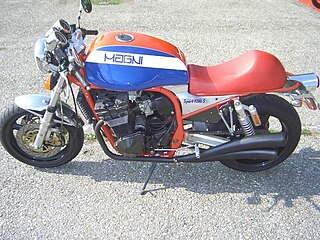
Magni is an Italian company that builds specialist motorcycles. The company is based in the city of Samarate in the province of Varese. Magni, in addition to building the bikes that bear its name, is also active in the construction of specials to order and a supplier of special parts for the restoration of MV Agusta classic motorcycles.

The Ducati 350 Mark 3 is a 340 cc (21 cu in) single cylinder bevel drive SOHC motorcycle produced by the Italian manufacturer Ducati from 1968 to 1974. It was one of the first 'wide case' Ducati singles produced. A higher performance version, the Ducati 350 Mark 3D, which used desmodromic valves was also available.

The Laverda 1000 is a series of 981 cc (59.9 cu in) air cooled DOHC triple motorcycles produced by the Italian manufacturer Laverda between 1973 and 1988. The high-performance variant, the Jota, was the fastest production motorcycle from 1976 to 1981. Approximately 7,100 triples of the various models were produced.
